Leading classification
This will depend on the type and quality of the material used in the manufacture of radiators. The main varieties include:
- made of cast iron;
- made of bimetal;
- made of aluminum;
- of steel.
Each of the materials has some disadvantages and a number of features, so to make a decision you will need to consider the main indicators in more detail.
Made from steel
They function perfectly in combination with an autonomous heating device, which is designed to heat a significant area. The choice of steel heating radiators is not considered an excellent option, since they are not able to withstand significant pressure. They are extremely resistant to corrosion, lightweight and heat transfer performance is quite satisfactory. Having an insignificant flow area, they rarely become clogged. But the working pressure is considered to be 7.5-8 kg/cm2, while the resistance to possible water hammer is only 13 kg/cm2. The heat transfer of the section is 150 W.
Steel
Made from bimetal
They do not have the disadvantages that are found in aluminum and cast iron products. The presence of a steel core is a characteristic feature, which made it possible to achieve colossal pressure resistance of 16 - 100 kg/cm2. The heat transfer of bimetallic radiators is 130 - 200 W, which is close to aluminum in terms of performance. They have a small cross-section, so over time there are no problems with contamination. Significant disadvantages include the prohibitively high cost of the products.
Bimetallic
Made from aluminum
Such devices have many advantages. They have excellent external characteristics and do not require special care. They are strong enough, which means you don’t have to worry about water hammer, as is the case with cast iron products. The working pressure is considered to be 12 – 16 kg/cm2, depending on the model used. Features also include a flow area that is equal to or less than the diameter of the risers. This allows the coolant to circulate inside the device at tremendous speed, which makes it impossible for sediment to deposit on the surface of the material. Most people mistakenly believe that too small a cross-section will inevitably lead to low heat transfer rates.
Aluminum
This opinion is erroneous, if only because the level of heat transfer from aluminum is much higher than, for example, that of cast iron. The cross section is compensated by the area of the fins. The heat output of aluminum radiators depends on various factors, including the model used, and can range from 137 to 210 W. Contrary to the characteristics given above, it is not recommended to use this type of equipment in apartments, since the products are not able to withstand sudden temperature changes and pressure surges inside the system (during the run of all devices). The material of an aluminum radiator deteriorates very quickly and cannot be subsequently restored, as is the case when using other materials.
Made from cast iron
The need for regular and very careful maintenance. A high rate of inertia is almost the main advantage of cast iron heating radiators. The level of heat transfer is also quite good. Such products do not heat up quickly, and they also give off heat for quite a long time. The heat output of one section of a cast iron radiator is equal to 80 - 160 W. But there are a lot of shortcomings here and the main ones are considered to be the following:
- Tangible weight of the structure.
- Almost complete lack of ability to resist water hammer (9 kg/cm2).
- There is a noticeable difference between the cross-section of the battery and the risers. This leads to slow circulation of the coolant and fairly rapid contamination.
Heat transfer from heating radiators in the table
Aluminum radiators
Aluminum radiators have a relatively low price and the highest heat transfer, that is, they quickly remove heat from the coolant and release it into the room. The sectional design and a wide range of standard sizes (depth, height) make it easy to obtain a battery of the desired configuration. The low weight of the material makes it possible to mount such radiators even on drywall, and the large fin area creates additional convection currents that increase heat transfer. Reinforced models of aluminum radiators can cope with a pressure of 12-16 atm, however, the main operational problem is the high requirements for the quality of the coolant - the pH of the water should not be less than 7.5.
This requirement is practically impossible to fulfill for central heating systems, where the water is highly acidic, and this in turn inevitably causes corrosion of aluminum. In addition, the electrochemical reaction of aluminum oxide with an acidic environment causes the release of hydrogen, which can lead to the formation of air locks if the design does not include exhaust valves.
Another nuance - there should be no antagonistic metals in the heating system. When paired with copper or brass components, the corrosion process starts (the more copper, the faster). To prevent contact of aluminum with water, manufacturers produce models of radiators with an internal coating made of polymers, ceramics or resins, but reliable statistics on such devices have not yet been developed. Thus, aluminum radiators are not recommended for use in city apartments, but they are well suited for autonomous heating systems with careful control of coolant parameters.
Formulas for calculating heater power for various rooms
The formula for calculating the heater power depends on the ceiling height. For rooms with ceiling height
- S – room area;
- ∆T – heat transfer of the heating device section.
For rooms with ceiling heights > 3 m, calculations are carried out according to the formula
- S – total area of the room;
- ∆T – heat transfer of a separate section of the battery;
- h – ceiling height.
These simple formulas will help you accurately calculate the required number of sections of the heating device. Before entering data into the formula, determine the real heat transfer of the section using the formulas given earlier! This calculation is suitable for an average incoming coolant temperature of 70˚ C. For other indicators, it is necessary to take into account the correction factor.
Let us give examples of calculations. Let's imagine that a room or non-residential premises has dimensions of 3 x 4 m, the ceiling height is 2.7 m (standard ceiling height in Soviet-built city apartments). Let's determine the volume of the room:
3 x 4 x 2.7 = 32.4 cubic meters.
Now let’s calculate the thermal power required for heating: multiply the volume of the room by the indicator required to heat one cubic meter of air:
Knowing the actual power of an individual radiator section, select the required number of sections, rounding it up. So, 5.3 is rounded to 6, and 7.8 – to 8 sections. When calculating the heating of adjacent rooms that are not separated by a door (for example, a kitchen separated from the living room by an arch without a door), the areas of the rooms are summed up. For a room with double-glazed windows or insulated walls, you can round down (insulation and double-glazed windows reduce heat loss by 15-20%), and in a corner room and rooms on high floors, add one or two sections “in reserve.”
Why doesn't the battery heat up?
But sometimes the power of the sections is recalculated based on the actual temperature of the coolant, and their number is calculated taking into account the characteristics of the room and installed with the necessary margin... and it’s cold in the house! Why is this happening? What are the reasons for this? Is it possible to correct this situation?
The reason for the decrease in temperature may be a decrease in water pressure from the boiler room or repairs from neighbors! If, during the renovation, a neighbor narrowed the hot water riser, installed a “warm floor” system, or began heating a loggia or glassed-in balcony on which he built a winter garden, the pressure of hot water entering your radiators will, of course, decrease.
But it is quite possible that the room is cold because you installed the cast iron radiator incorrectly. Typically, a cast iron battery is installed under a window so that the warm air rising from its surface creates a kind of thermal curtain in front of the window opening. However, with its back side, the massive battery heats not the air, but the wall! To reduce heat loss, glue a special reflective screen to the wall behind the heating radiators. Or you can purchase decorative cast-iron batteries in a retro style, which do not have to be mounted on the wall: they can be mounted at a considerable distance from the walls.
Thermal power of radiators
Some heating features
Single-pipe and two-pipe heating systems
- When installing autonomous heating, the instructions allow you to install both a single-pipe and a two-pipe circuit , but the connection diagram will change, and this may affect the power of the heating devices, so let's find out what both of these options are.
- Let's start with a single-pipe system and here we see that the coolant moves through a thick pipe, from which thinner ones extend, through which water under pressure enters the heater and returns back. The price of such a device is less, since it is necessary to heat less water, but there is a serious problem - with each battery the coolant becomes colder and colder, therefore, in such cases it is recommended to make do with three or four radiators and no more, since they are as they move away they lose their power.
- Things are completely different with a two-pipe system - here, of course, you will have to heat much more water, but when it enters the radiators through the supply pipe, it does not lose its temperature, since the cooled coolant is discharged into the return pipe. On such circuits, calculations of the power of radiators of various types will be most accurate.
The most effective place to place a radiator is under a window.
Note. In order for the most constant microclimate to be created in the room, there should be no leaks of warm air - this will also help to most accurately calculate the required heater power. So, radiators should be installed under the window, as in the photo above - hot air flows will rise upward and create a “curtain” from the penetration of cold air emanating from the glass.
How many radiators do you need for one room?
Installation of a bimetallic radiator
| Brand | marking | Axle distance | Parameters H/W/D (mm) | Working pressure maximum (bar) | Section thermal power (W) | Section volume (l) | Weight (kg) | Max. ᶷC | Guarantee period | Manufacturer |
| Global | STYLE 350 | 350 | 425/80/80 | 35 | 125 | 0,16 | 1,56 | 110 | 10 | Italy |
| STYLE 500 | 500 | 575/80/80 | 35 | 168 | 0,2 | 1,97 | 110 | 10 | Italy | |
| STYLE PLUS 350 | 350 | 425/80/95 | 35 | 140 | 0,17 | 1,5 | 110 | 10 | Italy | |
| STYLE PLUS 500 | 500 | 575/80/95 | 35 | 185 | 0,19 | 1,94 | 110 | 10 | Italy | |
| Tenrad | TENRAD 350 | 350 | 400/80/77 | 24 | 120 | 0,22 | 1,22 | 120 | 10 | Germany |
| TENRAD 500 | 500 | 550/80/77 | 24 | 161 | 0,15 | 1,45 | 120 | 10 | Germany | |
| Altermo | ALTERMO LRB | 500 | 575/82/80 | 18 | 169 | 0,15 | 2,5 | 130 | 5 | Ukraine |
| ALTERMO RIO | 500 | 570/82/60 | 18 | 166 | 0,15 | 2,0 | 130 | 5 | Ukraine | |
| Grandini | GRANDINI 350 | 350 | 430/80/82 | 16 | 130 | 0,26 | 1,55 | 120 | 5 | China |
| GRANDINI 500 | 500 | 530/80/80 | 16 | 167 | 0,38 | 1,85 | 120 | 5 | China |
Power table of bimetallic heating radiators depending on brand
Note. It should be noted that the metal from which the radiator is made has absolutely no significance when calculating the power of heating devices for a particular room. The fact is that the manufacturer always indicates in the accompanying documents the rated power of one section or the entire device, if it is a panel device.
The power of the bimetallic radiator section depends on the manufacturer
Now let's try to calculate the power of heating devices based on the area of the room, and for example we will use a room with a perimeter of 4.55 × 6.5 m using the formula S*100/P, but here we should immediately say that these calculations are valid if the ceiling height does not exceed 2.7m.
So, S (area) of the room we get 4.5 * 6.5 = 29.25 m2, and for the power of 1 section of the bimetallic radiator (P) we take GLOBAL STYLE 500 185 W, and the number 100 is the number of watts needed per m2 for Moscow and the Moscow region.
Since our room is quite large and we will need to find out the number of sections (K), this means Knumber of sections = S * 100 / P = 29.25 * 100 / 185 = 15.81 or 16 sections - this is one large or two medium ones radiator
Now let's calculate the required number of sections from the same manufacturer and with the same power for a room with the same area, but with ceilings whose height is more than 2.7 m and a height of 3 m can be taken as a calculation unit.
Therefore, we first need to calculate the value of V - the cubic capacity of the room, this is V = 4.5 * 6.5 * 3 = 88.5 m3. For the same Moscow and the Moscow region, 41 W of thermal energy needs to be generated per cubic meter of space.
This means that the total power needed for the room will be Ptotal=V*41=88.5*41=3628.5 W. This means that if the power of one section of the bimetallic radiator GLOBAL STYLE 500 is 185 W, then 3628.5/185 = 19.6 or 20 sections - this, of course, is already two radiators, since one will turn out to be too bulky.
But these calculations are only valid if the building is properly insulated and there are no drafts in the room.
General provisions and algorithm for thermal calculation of heating devices
The calculation of heating devices is carried out after the hydraulic calculation of the heating system pipelines using the following method. The required heat transfer of the heating device is determined by the formula:
, (3.1)
where is the heat loss of the room, W; when installing several heating devices in a room, the heat loss of the room is distributed equally between the devices;
— useful heat transfer of heating pipelines, W; determined by the formula:
, (3.2)
where is the specific heat transfer of 1 m of openly laid vertical/horizontal/ pipelines, W/m; is accepted according to the data in Table. 3 Appendix 9 depending on the temperature difference between the pipeline and the air;
— total length of vertical/horizontal/ pipelines in the room, m.
Actual heat output of the heating device:
, (3.4)
where is the nominal heat flow of the heating device (one section), W. Accepted according to the data in the table. 1 appendix 9;
- temperature pressure equal to the difference between half the sum of the coolant temperatures at the inlet and outlet of the heating device and the room air temperature:
, °C; (3.5)
where is the coolant flow through the heating device, kg/s;
— empirical coefficients. The parameter values, depending on the type of heating devices, coolant flow rate and flow pattern, are given in Table. 2 applications 9;
— correction factor, method of installing the device; is accepted according to the data in Table. 5 appendices 9.
The average water temperature in a heating device of a single-pipe heating system is generally determined by the expression:
, (3.6)
where is the water temperature in the hot main, °C;
— cooling of water in the supply line, °C;
— correction factors adopted according to table. 4 and table. 7 appendix 9;
- the sum of heat losses of the premises located upstream of the premises in question, counting along the movement of water in the riser, W;
— water flow in the riser, kg/s /determined at the stage of hydraulic calculation of the heating system/;
— heat capacity of water equal to 4187 J/(kg deg);
— coefficient of water flow into the heating device. Accepted according to the table. 8 appendices 9.
The coolant flow through the heating device is determined by the formula:
, (3.7)
The cooling of water in the supply line is found according to the approximate relationship:
, (3.8)
where is the length of the main line from the individual heating point to the design riser, m.
The actual heat transfer of the heating device must be no less than the required heat transfer, that is. The opposite relationship is allowed if the discrepancy does not exceed 5%.
Characteristics and Features
The secret of their popularity is simple: in our country, the coolant in centralized heating networks is such that it even dissolves or erases metals. In addition to a huge amount of dissolved chemical elements, it contains sand, particles of rust that have fallen off pipes and radiators, “tears” from welding, bolts forgotten during repairs and a lot of other things that are unknown how they got inside. The only alloy that doesn’t care about all this is cast iron. Stainless steel also does this well, but one can only guess how much such a battery will cost.
MS-140 - an undying classic
And another secret of the MS-140’s popularity is its low price. It has significant differences between different manufacturers, but the approximate cost of one section is about $5 (retail).
Advantages and disadvantages of cast iron radiators
It is clear that a product that has not left the market for many decades has some unique properties. The advantages of cast iron batteries include:
- Low chemical activity, which ensures long service life in our networks. Officially, the warranty period is from 10 to 30 years, and the service life is 50 years or more.
- Low hydraulic resistance. Only radiators of this type can be installed in systems with natural circulation (some also use aluminum and steel tubular ones).
- High temperature of the working environment. No other radiator can withstand temperatures above +130 o C. Most of them have a higher limit of +110 o C.
- Low price.
- High heat dissipation. For all other cast iron radiators, this characteristic is in the “disadvantages” section. Only MS-140 and MS-90 have a thermal power of one section comparable to aluminum and bimetallic ones. For MS-140, heat transfer is 160-185 W (depending on the manufacturer), for MS 90 - 130 W.
- They do not corrode when the coolant is drained.
MS-140 and MS-90 - difference in section depth
Some properties are a plus under some circumstances, and a minus under others:
- Large thermal inertia. It may take an hour or more until the MS-140 section warms up. And all this time the room does not heat up. But on the other hand, this is good if the heating is turned off, or a conventional solid fuel boiler is used in the system: the heat accumulated by the walls and water maintains the temperature in the room for a long time.
- Large cross-section of channels and collectors. On the one hand, even a bad and dirty coolant will not be able to clog them in just a few years. Therefore, cleaning and washing can be carried out periodically. But due to the large cross-section, more than a liter of coolant “fits” in one section. And it needs to be “driven” through the system and heated, which means extra costs for equipment (a more powerful pump and boiler) and fuel.
“Pure” disadvantages are also present:
Heavy weight. The weight of one section with an axial distance of 500 mm is from 6 kg to 7.12 kg. And since you usually need from 6 to 14 pieces per room, you can calculate what the mass will be. And you will have to wear it, and also hang it on the wall. This is another drawback: difficult installation. And all because of the same weight. Fragility and low working pressure. Not the most pleasant characteristics
Despite their massive size, cast iron products must be handled with care: they may burst upon impact. The same fragility leads to not the highest operating pressure: 9 atm
Pressure testing - 15-16 atm. The need for regular coloring. All sections come only primed. They will need to be painted often: once every year or two.
Thermal inertia is not always a bad thing...
Application area
As you can see, there are more than serious advantages, but there are also disadvantages. If we summarize everything, we can determine the scope of their use:
- Networks with very low coolant quality (Ph above 9) and a large number of abrasive particles (without mud traps and filters).
- In individual heating when using solid fuel boilers without automation.
- In networks with natural circulation.
How are section capacity and power related?
The power of bimetallic radiators is directly related to the size and capacity of the device. The less media in the battery, the more economical and efficient the device is . This is due to the fact that a smaller amount of working medium heats up much faster and less resources are spent on this. The section capacity depends on the center distance:
- 200 mm - the volume of coolant is from 0.1 to 0.16 liters.
- 350 mm - from 0.17 to 0.2 liters.
- 500 mm - from 0.2 to 0.3 liters.
Having data on the capacity and power of one section of a bimetallic radiator, you can calculate how much coolant is required to heat a particular room. For example: if the design of the device includes 10 sections with a center distance of 500 mm, then they will hold a total of 2 to 3 liters of water, and a radiator of 9 sections with a center distance of 350 mm holds about 1.6 liters of coolant.
At the same time, the strength of the heat flow of a 9-section bimetallic radiator with an interaxial distance of 350 mm allows you to effectively heat a room of 14 square meters. m.
What determines the power of cast iron radiators
Cast iron sectional radiators are a method of heating buildings that has been proven for decades. They are very reliable and durable, however, there are a few things to keep in mind. So, their heat transfer surface is somewhat small; about a third of the heat is transferred by convection. We first recommend watching the advantages and features of cast iron radiators in this video
The area of the MS-140 cast iron radiator section is (in terms of heating area) only 0.23 m2, weighs 7.5 kg and holds 4 liters of water. This is quite small, so each room should have at least 8-10 sections. The area of a cast iron radiator section should always be taken into account when choosing, so as not to get hurt. By the way, the heat supply in cast iron batteries is also somewhat slower. The power of a cast iron radiator section is usually about 100-200 W.
The operating pressure of a cast iron radiator is the maximum water pressure it can withstand. Typically this value fluctuates around 16 atm. And heat transfer shows how much heat one section of the radiator gives off.
Radiator manufacturers often overestimate heat output. For example, you can see that cast iron radiators heat transfer at delta t 70 °C is 160/200 W, but the meaning of this is not entirely clear. The designation “delta t” is actually the difference between the average air temperatures in the room and in the heating system, that is, with a delta t of 70 °C, the operating schedule of the heating system should be: supply 100 °C, return 80 °C. It is already clear that these figures do not correspond to reality. Therefore, it would be correct to consider the heat transfer of the radiator at delta t 50 °C. Nowadays, cast iron radiators are widely used, the heat transfer of which (and more specifically, the power of the cast iron radiator section) fluctuates around 100-150 W.
A simple calculation will help us determine the required thermal power. The area of your room in mdelta should be multiplied by 100 W. That is, for a room with an area of 20 mdelta, you will need a radiator with a power of 2000 W. Be sure to keep in mind that if the room has double-glazed windows, you should subtract 200 W from the result, and if the room has several windows, the windows are too large or it is corner, add 20-25%. If you do not take these points into account, the radiator will not work efficiently, and the result will be an unhealthy microclimate in your home. You should also not choose a radiator based on the width of the window under which it will be located, and not on its power.
If the power of cast iron radiators in your home is higher than the heat loss of the room, the devices will overheat. The consequences may not be very pleasant.
- First of all, when dealing with the stuffiness that arises due to overheating, you will have to open windows, balconies, etc., creating drafts that create discomfort and illness for the whole family, and especially for children.
- Secondly, due to the highly heated surface of the radiator, oxygen burns, air humidity sharply decreases, and even the smell of burnt dust appears. This brings particular suffering to allergy sufferers, since dry air and burnt dust irritate the mucous membranes and cause an allergic reaction. Yes, this also affects healthy people.
- Finally, incorrectly selected power of cast iron radiators is a consequence of uneven heat distribution and constant temperature changes. Radiator thermostatic valves are used to regulate the temperature and maintain it. However, it is useless to install them on cast iron radiators.
If the thermal power of your radiators is less than the heat loss of the room, this problem can be solved by creating additional electric heating or even completely replacing heating devices. And this will cost you time and money.
Therefore, it is very important, taking into account the above factors, to choose the most suitable radiator for your room.
Cast iron radiators
For many decades, cast iron radiators were the only type of heating device for most consumers - there was simply no other choice.
To be fair, it should be said that they have performed well, especially considering the low price. Cast iron has good thermal conductivity, is completely undemanding to the quality of the coolant (contamination, chemical aggressiveness, high temperature), holds pressure well, is strong and durable (its service life can be up to 50 years). The large mass causes high inertia - cast iron batteries warm up slowly, but retain heat for a long time when switched off. Their main disadvantages are the fragility of the material, due to which it does not withstand water hammer, as well as the peculiarities of the shape of the batteries: they require regular painting and collect a lot of dust.
Advantages and disadvantages of cast iron radiators
Cast iron radiators are manufactured using casting. The cast iron alloy has a homogeneous composition. Such heating devices are widely used for both central heating systems and autonomous heating systems. The sizes of cast iron radiators can vary.
Among the advantages of cast iron radiators are:
- Possibility of use for coolant of any quality. Suitable even for coolant with a high alkali content. Cast iron is a durable material and is not easy to dissolve or scratch;
- resistance to corrosion processes. Such radiators can withstand coolant temperatures up to +150 degrees;
- excellent heat storage properties. An hour after turning off the heating, the cast iron radiator will radiate 30% of the heat. Therefore, cast iron radiators are ideal for systems with irregular heating of the coolant;
- do not require frequent care. And this is mainly due to the fact that the cross-section of cast iron radiators is quite large;
- long service life - about 50 years. If the coolant is of high quality, then the radiator can last a century;
- reliability and strength. The wall thickness of such batteries is large;
- high heat radiation. For comparison: bimetallic heaters transfer 50% of the heat, and cast iron radiators – 70% of the heat;
- The price for cast iron radiators is quite reasonable.
Among the disadvantages are:
- heavy weight Only one section can weigh about 7 kg;
- installation should be done on a previously prepared, reliable wall;
- Radiators must be coated with paint. If after a while it is necessary to paint the battery again, the old layer of paint must be sanded. Otherwise, heat transfer will decrease;
- increased fuel consumption. One segment of a cast iron battery contains 2-3 times more liquid than other types of batteries.
Connection method
Not everyone understands that the layout of heating system pipes and proper connection affect the quality and efficiency of heat transfer. Let's look at this fact in more detail.
There are 4 ways to connect a radiator:
- Lateral. This option is most often used in city apartments in multi-storey buildings. There are more apartments in the world than private houses, so manufacturers use this type of connection as a nominal way to determine the heat transfer of radiators. To calculate it, a coefficient of 1.0 is used.
- Diagonal. An ideal connection, because the coolant passes throughout the entire device, evenly distributing heat throughout its volume. Typically this type is used if the radiator has more than 12 sections. When calculating, a multiplying factor of 1.1–1.2 is used.
- Lower. In this case, the supply and return pipes are connected from the bottom of the radiator. Typically this option is used for hidden pipe wiring. This type of connection has one drawback - heat loss is 10%.
- Single-pipe. This is essentially a bottom connection. It is usually used in the Leningradka pipe distribution system. And here there were heat losses, although they were several times greater - 30–40%.
Steel panel radiators
Steel panel radiators are welded plates 1.25-1.5 mm thick with stamped recesses that form connecting channels.
The main advantages of devices of this type are a large range of sizes (one, two or three panels 0.4-3 m long, 0.3-0.9 m high), high heat transfer per unit volume due to fins, low inertia and good adjustability. At a low cost, they are considered fairly effective devices. However, steel radiators also have a number of serious disadvantages, for example, a rather low operating pressure (6-8.5 atm).
With a water hammer of more than 13 atm, they can simply burst. They do not like steel radiators and dirty water, which causes siltation in their lower part. But the main problem is the formation of corrosion when draining the coolant, which significantly reduces the service life of the product. Thus, panel radiators are not the best option for use in city apartments with central heating, while they are ideal for autonomous systems in country houses. A single-panel radiator with a size of 300×400 mm and a power of 300 W will cost 1500-1650 rubles.
How to correctly calculate the actual heat transfer of batteries
You should always start with the technical data sheet that is attached to the product by the manufacturer. In it you will definitely find the data you are interested in, namely the thermal power of one section or panel radiator of a certain standard size. But do not rush to admire the excellent performance of aluminum or bimetallic batteries; the figure indicated in the passport is not final and requires adjustment, for which you need to calculate the heat transfer.
You can often hear the following judgments: the power of aluminum radiators is the highest, because it is well known that the heat transfer of copper and aluminum is the best among other metals. Copper and aluminum have the best thermal conductivity, this is true, but heat transfer depends on many factors, which will be discussed below.
The heat transfer stated in the heating device’s passport corresponds to the truth when the difference between the average temperature of the coolant (supply t + return t)/2 and in the room is 70 °C. Using the formula, this is expressed as follows:
For reference. In the documentation for products from different companies, this parameter can be designated differently: dt, Δt or DT, and sometimes it is simply written “at a temperature difference of 70 °C”.
What does it mean when the documentation for a bimetallic radiator says: the thermal power of one section is 200 W at DT = 70 °C? The same formula will help you figure it out, but you just need to substitute the known value of room temperature – 22 °C – into it and carry out the calculation in reverse order:
Knowing that the temperature difference in the supply and return pipelines should not be more than 20 °C, their values must be determined as follows:
Now it is clear that 1 section of the bimetallic radiator from the example will give off 200 W of heat, provided that there is water heated to 102 °C in the supply pipeline, and a comfortable temperature of 22 °C is established in the room. The first condition is impossible to fulfill, since in modern boilers heating is limited to 80 °C, which means that the battery will never be able to deliver the declared 200 W of heat. And it is a rare case that the coolant in a private house is heated to such an extent; the usual maximum is 70 °C, which corresponds to DT = 38-40 °C.
Calculation procedure
It turns out that the actual power of the heating battery is much lower than stated in the passport, but to select it you need to understand how much. There is a simple way to do this: applying a reduction factor to the initial value of the heater’s thermal power. Below is a table that shows the values of the coefficients by which you need to multiply the heat transfer rating of the radiator depending on the DT value:
The algorithm for calculating the real heat transfer of heating devices for your individual conditions is as follows:
- Determine what the temperature in the house and water in the system should be.
- Substitute these values into the formula and calculate your real Δt.
- Find the corresponding coefficient in the table.
- Multiply the rated heat transfer value of the radiator by it.
- Calculate the number of heating devices needed to heat the room.
For the example above, the thermal power of 1 section of a bimetallic radiator will be 200 W x 0.48 = 96 W. Therefore, to heat a room with an area of 10 m2, you will need 1 thousand W of heat or 1000/96 = 10.4 = 11 sections (rounding always goes up).
The presented table and calculation of the heat transfer of batteries should be used when the documentation indicates Δt equal to 70 °C. But it happens that for different devices from some manufacturers the radiator power is given at Δt = 50 °C. Then you can’t use this method, it’s easier to dial the required number of sections according to the passport characteristics, just take their number with a margin of one and a half.
For reference. Many manufacturers indicate heat transfer values under the following conditions: supply t = 90 °C, return t = 70 °C, air t = 20 °C, which corresponds to Δt = 50 °C.
Comparison of cast iron and bimetallic heating radiators
The coolant of the central heating system is not clean and neutral. In addition to chemical indicators, the liquid contains sand and pebbles. These abrasive elements have a destructive effect on both bimetallic and cast iron appliances, reducing their service life.
Which batteries heat better: cast iron or bimetallic?
The heat transfer readings of cast iron and bimetallic radiators are approximately the same, but there are differences. The former take a very long time to heat up, but cool down much longer compared to the latter. This saves you when accidents happen in winter and the heating is turned off to fix the problem. Cast iron models can retain heat for a long time. The thermal power of one section is 100-160 W.
Cast iron appliances heat the room using both convection and radiation methods. This ability allows objects located close to heating sources to heat up.
The results of measuring heat transfer with a thermal imager show the ability of cast iron structures to retain heat longer
Bimetallic radiators heat up very quickly. They also cool down quickly. Heating occurs according to the principle of convection, the radiative ability of heating interior items in the room is minimal. This is one of the disadvantages of a bimetallic heating device. Heat transfer power 150-180 W.
Which batteries hold pressure better?
The central heating system can rupture any radiator, because the pressure in it is not stable and water hammer occurs. Workers sometimes neglect the rules and turn on the valves of the circular pump not smoothly, as required by the instructions, but quickly. The pressure increases sharply and the devices burst. Residents of high-rise buildings (especially in buildings with more than five storeys) should give preference to devices with good pressure retention.
Attention! Experts recommend installing bimetallic radiators, as they can withstand up to 50 atmospheres, depending on the model.
Cast iron elements can withstand up to 9-12 atmospheres. If there is a strong water hammer, the radiators rupture.
Products with a monolithic core can withstand up to 100 atmospheres
Comparison of maximum coolant temperature
The temperature of the coolant in the central heating system is not stable. Temperature changes from warm to hot often occur. Cast iron radiators can withstand liquid heating up to 110 0C. Bimetallic elements – up to 130 0С. With sudden changes, steel makes cracking sounds.
Durability and service life
Cast iron appliances can operate for over 50 years. Proper care significantly extends their service life. Periodic flushing of the system and timely minor repairs extend the serviceability to 100 years and beyond.
The service life of bimetallic heating elements is set by manufacturers at 20 years for sectional ones and 25 years for monolithic models.
Easy to install
Installation of cast iron radiators is complicated by the weight of the devices. In addition to weight, it is necessary to consider a mounting system that will be able to support the mass of models. The brackets are made of high-strength steel. It is also necessary to take into account the reliability of the walls. Lightweight materials, such as drywall or gypsum panels, are not able to withstand such a load. Therefore, they either strengthen the walls with metal corners, or build a support from reliable building materials that can withstand heavy loads.
High-strength steel brackets for installing heating devices are an important fastening element
Modern manufacturers also produce floor radiators. When installing such structures, experts recommend making sure that the floor can support the weight of the devices.
The bimetallic heating structure is convenient to install. One person can handle the installation. Radiators are lightweight and do not require reliability of building materials.
Radiator cost comparison
Cast iron heating products are much cheaper than bimetallic ones. The cheapest section costs from 300 rubles, and the bimetallic section costs 500-700 rubles. Modern manufacturers offer artistic cast iron radiators. Their cost is high and varies around 2000 rubles.
Appearance comparison
Cast iron radiators come in 2 types: classic and artistic. The former look unattractive and require periodic painting. Artistic models with sinuous injection molding patterns can decorate the interior of a room, but this increases the cost of the products.
Bimetallic models have a ribbed-shaped shape.
External differences between cast iron and bimetallic heating devices lie in the shape of the sections and the presence of artistic elements
These types of radiators are classified as sectional. The length and height of the section is selected by the buyer from the options offered by the manufacturers. Usually the second parameter is 35-150 cm, and the depth is up to 50 cm. In accordance with the required heated area, the number of sections is selected, it is possible to modify the design.
Bimetallic models cannot be changed.
Radiator heat transfer, what does this indicator mean?
The term heat transfer means the amount of heat that a heating battery transfers to a room over a certain period of time. There are several synonyms for this indicator: heat flow; thermal power, device power. The heat output of heating radiators is measured in Watts (W). Sometimes in the technical literature you can find a definition of this indicator in calories per hour, with 1 W = 859.8 cal/h.
Heat transfer from radiators occurs through three processes:
- heat transfer;
- convection;
- radiation (radiation).
Each heating device uses all three heat transfer options, but their ratio differs for different models. Previously, it was customary to call radiators devices in which at least 25% of the thermal energy is released as a result of direct radiation, but now the meaning of this term has expanded significantly. Nowadays, convector-type devices are often called this.
The procedure for calculating the heat transfer of a heating radiator
The choice of heating devices for installation in a house or apartment is based on the most accurate calculation of the heat transfer of heating radiators. On the one hand, every consumer wants to save money on heating their home and therefore has no desire to purchase extra batteries, but if there are not enough of them, it will not be possible to achieve a comfortable temperature. There are several ways to calculate the heat transfer of a radiator.
Option one
. This is the simplest way to calculate heating radiators; it is based on the number of external walls and windows in them.
The calculation procedure is as follows:
- when the room has only one wall and a window, then for every 10 “squares” of area, 1 kW of thermal power of heating devices is required (for more details: “How to calculate the power of a heating radiator - we calculate the power correctly”);
- if there are 2 external walls, then the minimum battery power should be 1.3 kW per 10 m².
Option two
. It is more complex, but allows you to have more accurate data on the required power of devices.
In this case, the calculation of heat transfer from the heating radiator (batteries) is carried out using the formula:
S xh x41, where S is the area of the room for which calculations are performed; H - room height; 41 – minimum power per cubic meter of room volume.
The resulting result will be the required heat transfer for heating radiators. This figure is then divided by the rated thermal power that one section of a given battery model has. You can find out this figure in the instructions supplied by the manufacturer with your product. The result of calculating heating radiators will be the required number of sections so that the heat supply to a particular room is effective. If the resulting number is a fraction, then it is rounded up. A little excess heat is better than too little heat.
Technical characteristics of cast iron radiators
The technical parameters of cast iron batteries are related to their reliability and endurance. The main characteristics of a cast iron radiator, like any heating device, are heat transfer and power. As a rule, manufacturers indicate the power of cast iron heating radiators for one section. The number of sections may vary. As a rule, from 3 to 6. But sometimes it can reach 12. The required number of sections is calculated separately for each apartment.
The number of sections depends on a number of factors:
- room area;
- room height;
- number of windows;
- floor;
- presence of installed double-glazed windows;
- corner placement of the apartment.
The price given for cast iron heating radiators is per section, and may vary depending on the manufacturer. The heat dissipation of batteries depends on what material they are made of. In this regard, cast iron is inferior to aluminum and steel.
Other technical parameters include:
- maximum operating pressure – 9-12 bar;
- maximum coolant temperature – 150 degrees;
- one section holds about 1.4 liters of water;
- the weight of one section is approximately 6 kg;
- section width 9.8 cm.
Such batteries should be installed with a distance between the radiator and the wall of 2 to 5 cm. The installation height above the floor should be at least 10 cm. If there are several windows in the room, the batteries should be installed under each window. If the apartment is corner, then it is recommended to insulate the walls externally or increase the number of sections.
It should be noted that cast iron batteries are often sold unpainted. In this regard, after purchase, they must be coated with a heat-resistant decorative composition and must first be stretched.
Among domestic radiators, one can distinguish the ms 140 model. For cast iron heating radiators ms 140, the technical specifications are given below:
- heat transfer of the MS section 140 – 175 W;
- height – 59 cm;
- The radiator weighs 7 kg;
- capacity of one section - 1.4 l;
- section depth is 14 cm;
- section power reaches 160 W;
- section width is 9.3 cm;
- the maximum coolant temperature is 130 degrees;
- maximum operating pressure – 9 bar;
- the radiator has a sectional design;
- crimping pressure is 15 bar;
- the volume of water in one section is 1.35 liters;
- Heat-resistant rubber is used as a material for intersection gaskets.
It is worth noting that MS 140 cast iron radiators are reliable and durable. And the price is quite affordable. Which determines their demand in the domestic market.
Features of choosing cast iron radiators
To choose which cast iron heating radiators are best suited for your conditions, you need to take into account the following technical parameters:
- heat dissipation Select based on the size of the room;
- radiator weight;
- power;
- dimensions: width, height, depth.
To calculate the thermal power of a cast iron battery, you need to be guided by the following rule: for a room with 1 outer wall and 1 window, you need 1 kW of power per 10 sq.m. room area; for a room with 2 external walls and 1 window - 1.2 kW; for heating a room with 2 external walls and 2 windows - 1.3 kW.
If you decide to buy cast iron heating radiators, you should consider the following nuances:
- if the ceiling is higher than 3 m, the required power will increase proportionally;
- if the room has double-glazed windows, then the battery power can be reduced by 15%;
- If there are several windows in the apartment, then a radiator must be installed under each of them.
Modern market
Imported batteries have a perfectly smooth surface, they are of higher quality and look more aesthetically pleasing. True, their cost is high.
Among domestic analogues, we can highlight cast iron radiators Konner, which are in good demand today. They are characterized by a long service life, reliability, and fit perfectly into a modern interior. Konner heating cast iron radiators are available in any configuration.
- How to fill water into an open and closed heating system?
- Popular floor-standing gas boiler made in Russia
- How to properly bleed air from a heating radiator?
- Expansion tank for closed heating: device and principle of operation
- Gas double-circuit wall-mounted boiler Navien: error codes for malfunctions
Recommended reading
2016–2017 — Leading heating portal. All rights reserved and protected by law
Copying site materials is prohibited. Any copyright infringement will result in legal liability. Contacts
REPLACING THE HEATING RADIATOR
Of course, it is more convenient to change radiators outside the heating season, because there is no need to turn off the heat throughout the entire riser. However, in this case, possible connection defects will only be visible in the fall.
So winter work has its advantage: the installer is present when filling the system with water, the result is visible immediately, and problems are corrected on the spot. You and your neighbors will not have time to freeze, since the outage usually does not exceed a couple of hours.
The easiest way is to invite specialists from a local management company. When hiring a third-party contractor to DEZ, you will need to provide the company’s state registration certificate, certificates of conformity for materials, connection design and thermal engineering calculations (officially operating companies independently prepare all the necessary documents and even coordinate the disconnection of the riser).
Note when installing a heating radiator with your own hands:
- It is necessary to provide sufficient space around the radiator for the free movement of warm air: 7-10cm to the floor, 3-5cm to the wall, 10-15cm to the window sill. If these requirements are not met, heat loss will be 10-15%.
- The use of decorative screens reduces the heat transfer of radiators by about a third.
- The correct installation of the battery is under the window on the outside wall. The heated air will rise upward from the radiator, blocking the cold from the window, allowing for optimal heat distribution. If there are two windows in the room, radiators must be installed under each of them.
- The radiator must be installed strictly vertically/horizontally, then its heating will be uniform, and air will not begin to accumulate at the extreme points.
- On each battery it is necessary to install a thermostat (automatic or manual), as well as an air release valve (Mayevsky valve).
- It is more convenient to connect radiators through ball valves. If necessary, this makes it possible to completely disconnect them from the riser.
Table 1:
| COMPARATIVE CHARACTERISTICS OF THE MAIN TYPES OF RADIATORS | |||
| Radiators | Heat dissipation. W | Working pressure, atm | Crimping pressure, atm |
| Steel panel | 180-735 (depending on the number of panels) | 6-8,5 | 13 |
| Steel tubular | 20-700 (depending on dimensions) | 8-10 | 13-15 |
| Cast iron | 80-160 (one section) | 10-12 | 15-18 |
| Aluminum | 125-280 (depending on the center distance) | Up to 16 | 24 |
| Bimetallic radiators (aluminium/steel) | 130-200 (depending on the center distance) | Up to 35 | 52,5 |
What to consider when calculating
Calculation of heating radiators
Be sure to take into account:
- The material from which the heating battery is made.
- Its dimensions.
- The number of windows and doors in the room.
- The material from which the house is built.
- The direction of the world in which the apartment or room is located.
- Availability of thermal insulation of the building.
- Type of pipe system layout.
And this is only a small part of what needs to be taken into account when calculating the power of a heating radiator. Don’t forget about the regional location of the house, as well as the average street temperature.
There are two ways to calculate the heat transfer of a radiator:
- Regular - using paper, pen and calculator. The calculation formula is known, and it uses the main indicators - the thermal output of one section and the area of the heated room. Coefficients are also added - decreasing and increasing, which depend on the previously described criteria.
- Using an online calculator. It is an easy-to-use computer program into which certain data about the size and design of the house is loaded. It gives a fairly accurate indicator, which is taken as the basis for designing a heating system.
For the common man, both options are not the easiest way to determine the heat transfer of a heating battery. But there is another method for which a simple formula is used - 1 kW per 10 m² of area. That is, to heat a room of 10 square meters, you will need only 1 kilowatt of thermal energy. Knowing the heat transfer rate of one section of a heating radiator, you can accurately calculate how many sections need to be installed in a particular room.
Let's look at a few examples of how to correctly carry out this calculation. Different types of radiators have a large size range, depending on the center distance. This is the size between the axes of the lower and upper manifold. For the bulk of heating batteries, this figure is either 350 mm or 500 mm. There are other parameters, but these are more common than others.
This is the first one. Secondly, there are several types of heating devices made of various metals on the market. Each metal has its own heat transfer, and this will have to be taken into account when calculating. By the way, everyone decides for themselves which radiator to choose and install in their home.
Bimetallic radiators
This type of heating device is considered the most optimal in design.
Advantages of bimetallic radiators. Main characteristics:
- The strength of steel pipes and the excellent thermal conductivity of aluminum - the coolant flows through steel pipes, and the increase in temperature is removed through aluminum fins.
- The amount of water in the section is the lowest when compared with other types of similar equipment - within 150 ml (as a result - high efficiency).
- They have all the positive qualities of steel and aluminum batteries.
- Since steel pipes completely exclude contact of aluminum with the coolant, gas formation is completely absent.
- Strength of structures (resulting in operating pressure up to 30 bar).
- Aluminum gives bimetallic heating devices an excellent design and provides good thermal conductivity.
- Well suited for installation in central and autonomous heating systems.
Bimetallic batteries have only one drawback - quite high cost.
To make a final decision on which radiators to purchase, you should take into account all the characteristics of the equipment, make a list of requirements for the heating devices to be purchased, and only then buy the necessary radiators for rooms that require heating.
The best posts
- Crocheting a washcloth: master classes with photos and videos
- [Plants in the house] Hemanthus: growing secrets
- DIY candle holder from a glass jar: ideas for Halloween
- Herringbone parquet: types of deck installation, piece board technology, square layout, device options
- Small balcony: design and photo
- Fukra fabric: description, composition, properties, care
- Weaving patterns: beaded baubles with names on a machine for beginners
- Cozy design: which is better, wall painting or wallpaper?
Related article: What dry building mixtures exist for plastering work?











